Mallorca Wine Guide: Vineyards, Wineries and Wines
At Click-Mallorca.com our local wine experts have created a Mallorca wine and travel guide for visitors to Mallorca and locals too. Let us help you to discover the scenic vineyards, best bodegas and most interesting wines. Our aim is to show you why Mallorca wines are special and to help you discover an exciting and diverse range of wines.
Most people visiting Mallorca immediately associate the island with sun, sea and sand and don’t realise what rich gastronomy, culture and interesting wines are on offer. When people think of wine regions in Spain, the places that usually spring to mind are commercially famous wine regions such as La Rioja, Ribera del Duero and Cava, as well as regions producing very high quality wines like Jerez and Priorat.
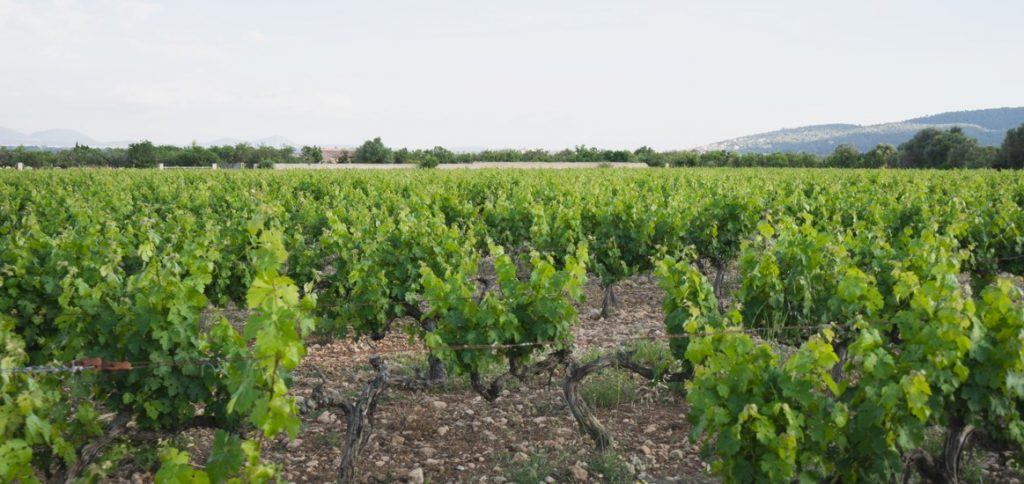
Perhaps you didn’t even know that Mallorca produces a lot of wine. In fact, the wine industry in Mallorca is a very important one. Here we are going to help you to enjoy Mallorcan wines and give you information to discover new things and to find your style.
Mallorca Wine Overview
Here in Mallorca, we aren’t interested in what other wine regions in Spain, like the aforementioned Rioja and Ribera del Duero, are doing: Mallorca is finally finding its own style, and the wineries here are working on exciting new projects to create quality wines using native grape varieties. They are beginning to focus on quality rather than quantity. In our opinion, it’s one of the best things to have happened to Mallorca wine in the last decades. It’s like the wine makers are shouting from the roofs of their bodegas about their local product and the special conditions that allow them to produce different wines with great success instead of following the crowd and doing what everyone else is doing.
You see, there was a time when all Mallorcan wine pretty much tasted the same: fashionable French grape varieties were used and everyone followed the same elaboration procedure. Not any more. Mallorcan wine producers have found their pride in their own product.
It’s not just here in Mallorca where the penny has finally dropped, but the trend nowadays (and we really hope this is more than a trend – a way of life) is for wine makes to use their own native grapes, to nourish the soil and the conditions that you have in their area, and to produce the best wine they can adapting to the needs of the grape, and the climatic circumstances. For example, in Canary Islands they are producing some great wines using their local varieties and embracing the very special type of terrain they have there: volcanic rock. Similarly in Catalunya, there are many wine regions that are all doing their own thing with their own grape varieties – and they are doing it very well; just look at the amazing wines coming out of Emporda lately.
Anyway, Mallorca…
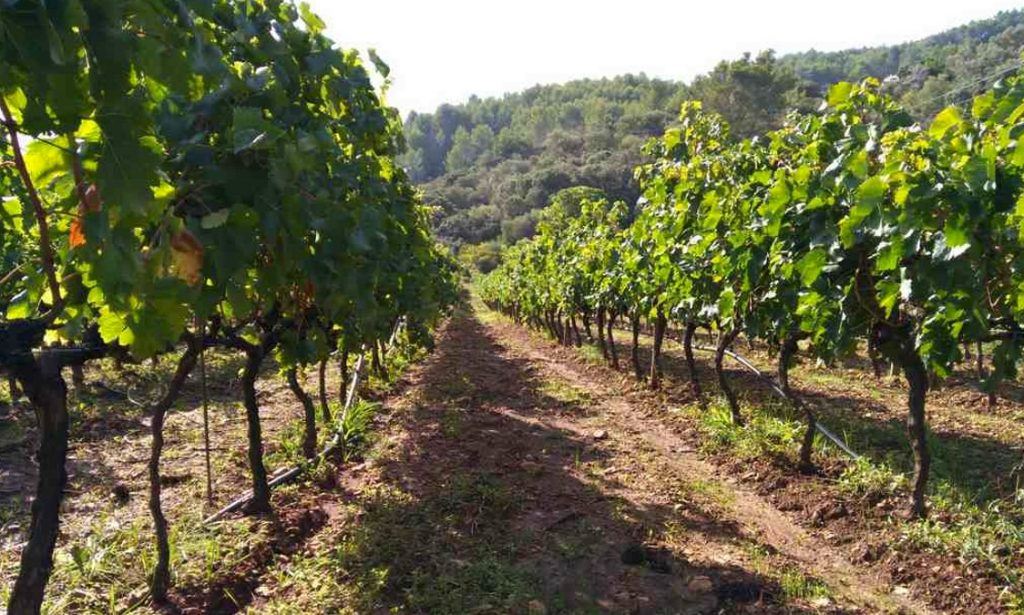
If you visit Mallorca you will find that the wine produced locally is very popular. Sit down in any restaurant or bar and the majority of wines on the menu will be from Mallorca. In a normal year, Mallorca receives 9 million tourists (to understand this proportionally, the population of the island is just under 1 million inhabitants). This gives Mallorca a great base to promote its wines, because most of those visitors are on holiday, will eat out at a restaurant and will possibly even visit one of the wineries. This means that Mallorca doesn’t have to rely so much on the export market to sell its wines, as most wines are consumed right here on the island.
Spain has many “Denominaciones de Origen” (Appellation of Origin or Designation of Origin) relating to wine and gastronomy, in much the same way as other countries do. The most famous wine regions of Spain being La Rioja and Ribera del Duero, as mentioned. The “Denominacion de Origen” (D.O.) gives prestige to a product and is like a stamp to say that it is a product of quality, made from a certain ingredient(s) and elaborated under certain quality guidelines. For example, Cornish Pasties in the UK have a stamp of appellation of origin if they are indeed produced in Cornwall and if they follow a traditional recipe. Same thing applies to Yorkshire puddings, French Champagne and millions of other products that need their authenticity protecting. The wine in each D.O. in Spain is produced according to that region’s stipulations.
Mallorca Wine Regions
Mallorca has two of its own D.O. wine regions, plus another appellation for those wines produced outside of the parameters of the D.O. requirements.
Binissalem, Mallorca
Binissalem itself is a town in Mallorca with stone buildings, pretty streets and a lot of local history, much of which relates to wine and its production. If we speak about wine, we normally refer to Binissalem as the most famous and biggest wine region in Mallorca. Wine with a Binissalem D.O. includes wine produced in and around Binissalem itself, as well as wines from the towns and villages of Consell, Santa Maria, Santa Eugenia and Sencelles.
Wines from Binissalem are medium bodied wines that express the red clay soil typical of the area. The main local grapes used in wines from Binissalem are the mantonegro for red wines and the premsal blanc for white wines. They are usually combined with other grape varieties to add balance, body and flavour. The mantonegro is a delicate red variety with few tannins and a low alcoholic gradient, therefore it combines perfectly with shiraz or cabernet sauvingnon. The Binissalem wines reflect the climate, which is warm, although some wine producers in the area are trying to use more mantonegro and less international varieties to create fruitier and fresher wines. This is a recent trend, as the mantonegro is difficult to work with in the wine cellar and oxidises easily.
When you are tasting wines from Binissalem, it is a great idea to try a more traditional Binissalem red and to compare it with a 100% mantonegro if you can find one.
Pla i Llevant
The Pla i Llevant wine region is in the central area of Mallorca and is not as well-known as Binissalem, though many of the island’s best wines are from this region. “Pla” refers to the plain of Mallorca, meaning the open countryside and “Llevant” is the name of a wind that lands on the island. Both add characteristics to the wine produced in this area.
The D.O. was founded in 1999 and covers 19 municipalities in Mallorca. 14 bodegas are registered in the D.O. Pla i Llevant as well as 79 winegrowers cultivating 472 hectares of grapevine. There are a great many varieites grown in Pla i Llevant, but lately bodegas in the region are giving preference to indigenous grapes, with the callet being one of the most important, but also including fogoneu, gorgollassa, giro ros, premsal blanc (moll) and mantonegro among others.
The vines in Pla i Llevant are less than 100m above sea level and enjoy a Mediterranean climate with mild temperatures in winter and warm summers.
The white wines from Pla i Llevant are intensive in flavour and are fruity, with good acidity. The red wines are well-rounded Mediterranean wines with balsamic notes.
Vi de la Terra de Mallorca
Vi de la Terra de Mallorca (or wine from the land of Mallorca) is the label given to wine produced on the island but not inside either of the D.O.s. This may be because the bodega is not a member of the D.O. and is not interested in the label, it may be because the bodega is geographically outside the perimeters of the D.O. or it could be because the wine does not meet one or more of the stipulations of the D.O., such as the grape varieties used, the process used to elaborate the wine, or for agricultural reasons. Sometimes wine producers with their wine cellar registered under their relevant D.O. also produce wines without that prestigious stamp of approval simply to give them more freedom to experiement with grape varieties or try unusual experiements in the production stage, which aren’t recognised by the D.O.
So if you see a wine with the appellation Vi de la Terra de Mallorca, don’t automatically think that it wasn’t good enough to get the D.O. stamp – you could have found something very interesting!
Is Mallorca Wine Good?
Is Mallorca wine good? Well everything is relative, isn’t it. But generally speaking, yes, Mallorca wine is good. In fact, it tends to be VERY good.
There was a time when Mallorcan wines, like many other Spanish wines at the time, were made almost exclusively from French grapes. Chardonnay, Merlot, Cabernet Sauvignon and Shiraz were planted all over Spain and there was little to distinguish one wine from another and very little to express the region the wine was produced in. It’s perfectly understandable that commercial bodegas wanting to get the biggest production and earn the maximum amount of money would go for the safe option, knowing that these French grapes would give an excellent yield in any vineyard.
However, times have changed and many regions of Spain are going back to their roots, using their native grapes and even going back to production techniques that just a decade ago were considered anticuated. Mallorca is no different and nowadays some of the best wines and most interesting Mallorca wines are those that use the indigenous grapes from the island.
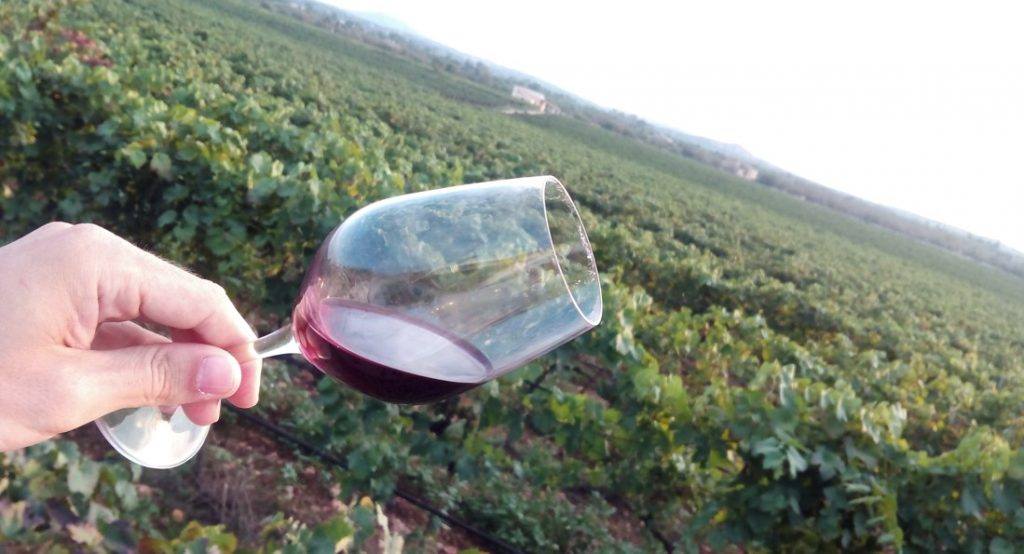
Grape Varieties used in Mallorcan wines
As mentioned, in Mallorca, grapes from other parts of the world also grow and are used in wine production. But you can read about those anywhere. The most interesting grapes are the indigenous varieties from the island, which are only found in Mallorca and used only in Mallorcan wines.
Some Mallorcan grape varieties that you will not find anywhere else in the world are:
Red Wines
Mantonegro
Mantonegro is a native grape variety of the Balearic Islands, cultivated mainly in the Binissalem D.O. It is almost exclusively found on the island of Mallorca with 320 hectares (790 acres), making it the most widely planted grape variety on the island.
Mantonegro is a late-ripening grape variety that buds early in the growing season and produces average size clusters of large, thick-skinned grapes. In rich and fertile soils the variety can be very productive and high yielding with the vine performing best in stony vineyard soils, which is why is it perfectly suited to the growing conditions offered in Binissalem. Mantonegro is sensitive to mildew, one of the most serious known diseases for grapes and other fruit-producing plants.
The wines obtained from mantonegro are aromatic, full-bodied, alcoholic, light, very balanced and with successful results after a brief aging in barrel and in the bottle. It performs well in wood, complementing other varieties.
Callet
Callet is often used to make light-bodied red wines that may be blended with Cabernet Sauvignon, Tempranillo or Syrah. Although the Callet grape is deeply coloured, it tends to be quite low in alcohol. The Callet wines, however, have very soft tannins and tend to be ruby coloured. They normally have sweet flavours of red fruit such as raspberry, cherry and blackberry.
Callet wines do not develop a high degree of alcohol, and this is one of the characteristics that does not make this variety very easy to work with. Some compare it to Pinot Noir.
Gorgollassa
This variety was grown extensively in the past, although nowadays its production is less widespread. Due to its aromas, tones and good response in the mouth, it has now been recovered. The leaves are medium-sized with a cottony underside. The cluster is medium-sized, slightly compact and cylindrical in shape. The grapes have a spherical shape and a blue-black colour. The yield per hectare is relatively low and it buds and ripens late.
Wines made with Gorgollassa are low in alcohol content and have good concentration of anthocyanins and tannins.
Fogoneu
The Fogoneu grape variety is probably the least-known of Mallorca’s grapes, but curiously, was the most planted grape on the island in the latter part of the 19th century and early 20th century. It is an indigenous variety to Mallorca and has its biggest presence in the Felanitx area.
It is used in both red and rosé wines. It is most commonly found in the vineyards of Mallorca alongside the dominant local varieties, Callet and Mantonegro. These three varieties are typically blended together, with Fogoneu usually forming less than five percent of the final blend. Varietal Fogoneu wine is extremely rare.
Because of its thin skins and pale colour, Fogoneu has been likened to the Gamay variety of Beaujolais, but there is actually no known relationship between the two.
White Wines
Malvasía
Believed to be of Greek origin, the Malvasia family has been commercially important to the Mediterranean for more than 2000 years. Malvasia, the name, is a derivation of the coastal Greek town of Monemvasia. However, Malvasia has a long history in Mallorca with 16th Century records showing a production of some 250,000 litres, most of which was exported to Europe due to its excellent reputation.
Though often blended with other grapes during wine production, it is possible to find single varietal bottles, and the taste will depend on when it was harvested and how it was matured. Early harvested Malvasia will have a soft but intricate flavour. Late harvest Malvasia, is frequently used to make dessert wine due to its high alcohol content. The wine is golden in colour and reminds you of stewed soft fruits accompanied with some spicier balsamic notes.
Moll (Premsal Blanc)
Moll or Premsal Blanc is a native white grape variety frequently found in both wines from the Binissalem and the Pla i Llevant regions.
It is an extremely resilient vine that produces a good yield, and copes well with the dry soils associated with the island.
It has an abundance of citrus and stone fruit aromas but little acidity, which makes it an ideal candidate for blending with other grapes, such as Malvasia, Chardonnay or Macabeo. Blends usually result in a light straw-coloured wine, of balanced acidity, with floral and fruity aromas, and are at their best when drunk young.
You’ll also find Moll incorporated into some Spanish sparkling-wine blends.
Giro Blanc
Following extensive research it is widely believed that Giró Blanc is one of the island’s few indigenous grape varieties, and not related to similarly named varieties found in Italy. There are several sub-varieties of the “giró” family in Mallorca and they are currently being investigated and experimented with. None of the giró grapes are currently accepted under the rules of the D.O.s of Mallorca (which is where that third stamp Vi de la Terra de Mallorca comes into play, so that wine producers are able to produce wines and commercialise them using little-known and highly interesting grape varieties).
This late-ripening vine bears pink-coloured thick-skinned grapes. The white wine produced is aromatic and alcohol-rich, often with buttery notes and aromas of peach, apricot, and exotic fruits. The wine has a clear straw colour, although barrel ageing results in a wine with more golden tones.
Five Wineries to Discover in Mallorca
Mallorca has over 70 bodegas, or wineries, which commercialise and bottle their own wines, most of which are located in one of the two appellations of origin: Binissalem and Pla i Llevant. Though, there are vineyards in other regions of the island, including in the Serra de Tramuntana Mountain area, where the wines produced have a certain freshness from the lower temperatures and the Tramuntana wind.
You can visit the larger wineries such as Macia Batle and Jose Luis Ferrer, that give large organised tours following a set route, a set speech and a set wine tasting programme. If you are looking for an introduction to Mallorca wine then these types of bodega tours are ideal, as you will visit the vineyards, learn about local grape varieties, see the process of the production of wine and then finally taste four or five wines.
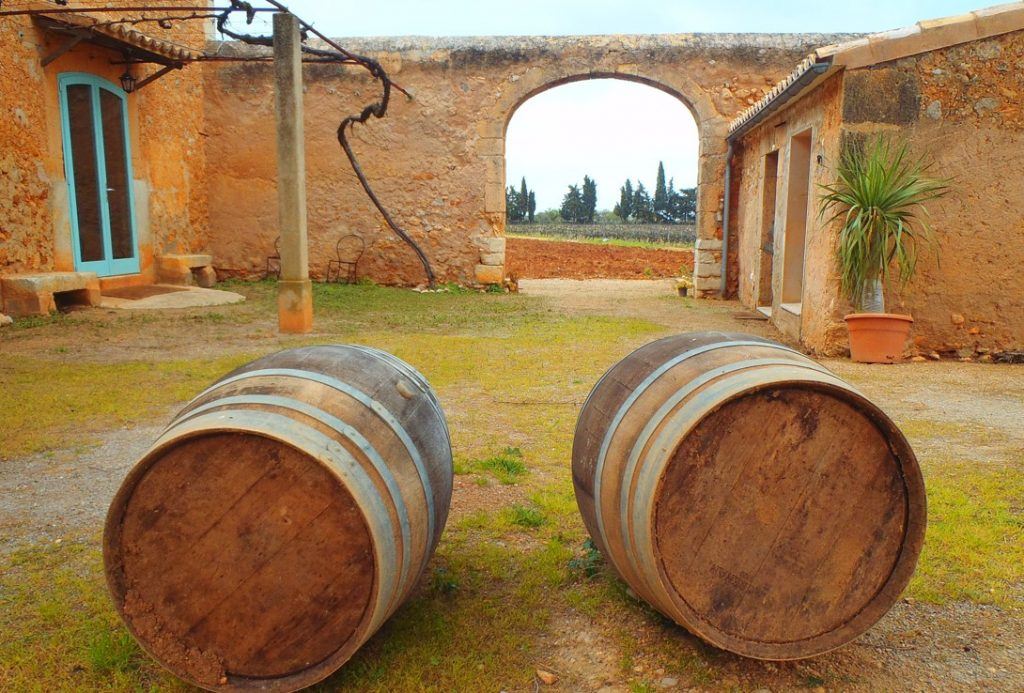
However, if you want to discover less commercial bodegas that are studying interesting projects and experimenting in the vineyards and in the bodega, then these wineries are our top five:
1. Bodega Biniagual
Biniagual is a hamlet that dates back to the moorish epoch in Mallorca and is situated in the heart of the wine-growing district of Binissalem. The Bodega Biniagual contains about 34 hectares of wine-growing area with more then 148.000 vines. As well as cultivating local grape varities, they also work with shiraz, chardonnay, viognier and cabernet sauvignon. However, the main variety used in the wine production at Biniagual is the local mantonegro and their rose wine is made 100% from this grape.
The hamlet of Biniagual consists of 14 houses, a chapel, and the historic winery, as well as a complete, typical Mallorcan farm belonging to the traditional Mallorcan estate. Wine was already being produced at this estate in the 13th century when the inhabitants of the hamlet all worked for the main estate. Apart from producing great vino, the hamlet of Biniagual is a picture-perfect example of Mediterranean immaculateness with its stone buildings, bright and colourful gardens and fields of grapevines with a backdrop of mountains and blue sky.
The winery offers different tasting options and guided tours which you can book in advance to enjoy a tour of the vineyards and the installations. Or you can book a gastronomic experience with wine and tapas. You can also simply drop by without an appointment and enjoy a glass or a bottle of wine in a stunning location.
2. Vins Dalt Turo
Dalt Turo is a very interesting winery in Campos, Mallorca. Interesting because it is a unique winery that is located inside an old sandstone quarry. This means that the grapevines cultivated here grow in different conditions to those of other bodegas on the island. The subsoil the grapevines call home was formed by dune systems of the Pleistocene and Pliocene during which the entry and exit of the sea in the basin of Campos caused the emergence of large areas of seabed sandstones that were accumulated by the action of wind between 3.6 and 0.7 million years ago.
All the wines produced are from grapes grown in the soil formed from the old sandstone quarry. The bodega produces three red wines, a white and a pale rose. The wines are all under the appellation Vi de la Terra de Mallorca. The grapes used are a combination of local varieties and international varieties. They only work with red varieties, which means that the white wine is a “blanc de negres” (a white wine made from red grapes).
You can visit Dalt Turo and enjoy a tasting of their wines combined with a unique tour of the vineyards, on which you can discover the special landscape of forest and quarry.
3. Galmes i Ribot
Located in the middle of the countryside of the north of Mallorca, you will find the Galmes i Ribot estate. The winery and shop, run by Catalina Ribot, the owner, are located in the middle of the vineyards. Catalina Ribot is one of the islands most important ambassadors of indigenous grape varieties and a visit to her bodega is a joy for those interested in experiements, as there are plenty going on.
The location of this wine cellar in Santa Margalida, with stunning views of the countryside is Mediterranean perfection, but there is perhaps less to see in the sense of installations and equipment. However, if you wish to taste some of the island’s history, then this is the wine cellar to visit. Currently Galmes i Ribot are investigating the Escursac grape, which is a variety that was all but lost in Mallorca and no bodega cultivated it or used it in their wines. Escursac is not even currently authorised in any of the D.O.s in Mallorca. Catalina Ribot is working very hard to change that and revive part of the island’s history. And she has the backing and help of many other like-minded wine makers in Mallorca. We expect before long to be able to buy escursac wines elaborated by different wineries with a label proudly stating that this wine is a D.O. Pla i Llevant or a D.O. Binissalem.
4. Oliver Moragues
Located in Algaida, close to the Puig de Randa, Oliver Moragues is one of the most beautiful wineries you can visit. The winery is set in a beautiful estate on which there is an old “possessio” (Mallorcan manor house) and which has been converted into a rustic luxury hotel. Wine has been produced here for 500 years by the same family that owns the property today. The grounds are stunning and you can also walk around the vineyards enjoying the wonderful views.
At Oliver Moragues, the philosophy is to use local products and to care for the land. Nowhere is it clearer that viticulture and agriculture go hand in hand. Focus in the wine production is very much on the local grape varieties, with callet, mantonegro, gorgollassa the focus of their reds. In fact they produce a wine that is 100% mantonegro and a wine that is 100% callet. They also produce a very exciting white wine with the little-known giro ros grape variety which you should certainly try if you get the opportunity. However, this wine is in high demand and production is low.
The farm is sustainable, with chickens and donkeys providing the principal fertiliser for the grapevines. Wild flowers, trees and other plants are nurtured, not ripped up, to encourage biodiversity. The wines produced are balanced and structured, which in part is due to the soil, which is a combination of clay, gravel and sand.
5. Anima Negra
Anima Negra, a wine cellar situated in the ancient estate of Son Bruguera near Felanitx, produces one of the most renowned and prestigious wines on the island, by the same name, which is sold in more than 40 countries around the world. Anima Negra (the wine) uses the local callet grape variety with a tiny percentage of mantonegro and fogoneu. This wine was an instant hit with critics and received the highest notes from prestigious wine guides, It is now one of Mallorca’s ambassador wines.
The estate dates from the 8th Century and wine has been produced there since its beginnings, though the bodega Anima Negra was not born until 1994. Today they have more than 55 hectares of their own vines, but when they started producing the Anima Negra wine, before they had such production of their own, they would rent grapevines and buy kilos of grape.
9 Mallorcan wines to try
Now that you know about the vineyards and the grape varieties used in Mallorcan wines. Now that you understand about the different wine regions on the island and the “Denominaciones de Origen”. Now that you know which wineries to visit and what to look for when you are there…
It’s time to try the wines!
There are hundreds of Mallorcan wines to try. Thousands, in fact. But here we have narrowed it down to our top 9 wines to try, based on local grape varieties or something that makes each one stand out from the rest.
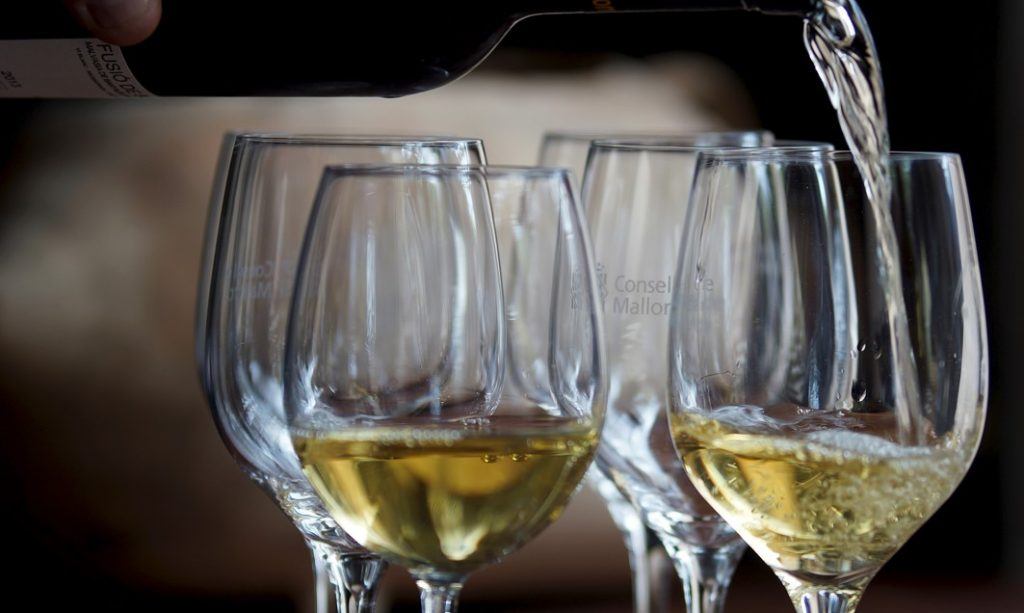
1. S’ERA Giro Ros, Oliver Moragues
- Grape varieties: Giro Ros
In 2021 the Oliver Moragues winery began elaborating wines using local varietals, always with the aim of a good balance between alcohol and acidity. One way they achieve this with the monovarietal giro ros is by harvesting the grapes earlier than usual. The wines, therefore, are somewhat delicate and elegant, as normally this grape produces wines with a higher alcohol content and harsher flavours. Giro Ros has a very low yield, which makes each grape a small treasure, and provides elegance and structure throughout the wine. Light floral nose with a spicy touch. Pure elegant power, nice density, structure and lively acidity, ending in a long finish.
The name S’ERA is the name of one of the parcels of the property. It is the highest and rockiest area with calcareous clay soils. S’ERA is a range of wine by this bodega which use monovarietal indigenous grapes.
2. Gran Verán, Finca Biniagual
- Grape varieties: Mantonegro, shiraz
- Serving temperature: Between 16ºC and 18ºC
- Alcohol: 14.5%
A complex and deep nose, with ripe cherry, smoked and toasted notes with hints of eucalyptus, clove and coffee. On the palate, noble and sweet with round and soft tannins; elegant and silky and a very persistent finish.
For this limited production wine, the best quality grapes of Mantonegro and Shiraz are selected, which are harvested by hand in 12kg boxes. After the selection in the vineyard, there is a second selection in the cellar. Fermentation takes place partly in French oak barrels, and partly in a 4,600-litre stainless steel tank. Malolactic fermentation in new French oak barrels.
The aging takes place for 18 months in new French oak barrels of 225 liters with a medium toast.
3. 4 Kilos, 4 Kilos Vinícola
- Grape varieties: 100% callet
- Production: 16,000 bottles (plus 300 magnums)
- Alcohol: 12%
4 Kilos is a red wine produced by the Vinícola 4 Kilos winery with grapes from the native variety of Mallorca, Callet. The name 4 Kilos refers to the initial investment Francesc Grimalt and Sergio Caballero made when they started the 4 Kilos wine cellar (4 million pesetas, a million being coloquially referred to as a kilo).
A red with 12 months of aging in barrels, emblem of the winery from which it takes its name, which shows that a good wine does not depend on a great economic effort but on an ambition for quality and a passion for the product.
4. Chateau Paquita, Sistema Vinari
- Grape varieties: 65% Callet, 20% Manto Negro, 15% Monastrell
- Serving temperature: 15ºC
- Pairing note: Grilled red meats, Poultry
Chateau Paquita is a red wine produced by Sistema Vinari in Felanitx, Mallorca. It is a blend of Callet, Mantonegro and Monastrell. All the varieties ferment separately and the Monastrell undergoes a semi-carbonic maceration. During fermentation, very light treading is carried out with the hands and then it is transferred to used 500-litre barrels. The coupage is made and it rests for 3 months in vats and 6 months in the bottle.
5. Som Pubil, Galmes i Ribot
- Grape varieties: Escursac 100%
- Alcohol: 12%
In 2006, Galmés i Ribot winery planted an experimental vineyard with lost or lesser-known Mallorcan grape varieties to gain an in-depth understanding of their potential. The Escursac was one of these grapes.
In 2017 they released the first vintage of the 100% Escursac wine, which they called Som Pubil (“only child” in Mallorquin). It ferments in 300-litre used French oak barrels with indigenous yeasts and is aged for four months. The wine is bottled without filtering or clarifying.
Persevere with the nose because when it opens up, ripe red fruit appears along with hints of yeast and spices. Its entry is smooth and fresh, with high but very pleasant acidity, and very soon we find black fruit and toasted sugar in a wine that evolves a lot in the glass and becomes more and more expressive.
6. Tianna Bocchoris Blanco, Celler Tianna Negre
- Grape varieties: Premsal blanc, Sauvignon blanc and Giró ros.
- Serving temperature: Between 6ºC and 7ºC
- Pairing note: White fish in creamy sauce.
Tianna Bocchoris by Celler Tianna Negre in Binissalem is made using Premsal blanc (Moll) and Sauvignon blanc grapes, the latter having been allowed to age in barrels of new French oak. This white wine has a golden yellow colour with greenish reflections. Aromas of white fruit (peach) and exotic fruit (papaya) with a background of toasted notes from its time in the barrel. Long aftertaste with hints of ripe white fruit.
Little more than 3000 bottles are produced per vintage.
7. Acopinyat, Dalt Turo
- Grape varieties: Callet 60%, Mantonegro 20%, Merlot 15%, y Cabernet Sauvignon 5%.
- Alcohol: 12.5%
- Production: 7248 bottles
This is a white wine made using only red grapes, known locally as a “blanc de negres”. The grapevines are grown in “Call Vermell” (the name of the red clay soil in this region). The winery and its vineyards are on the plot of an old stone quarry with high clay content and little depth. The underground is made up of ancient dunes fossilized seascapes in marès (calcareous sandstones), some of which are 3 million years old.
The main grape used in this wine is the callet grape, which is normally used in light reds and rosés. For this wine the grapes selected are the ones from the youngest vines. They are pressed very lightly and marceration is without the skins giving a straw-coloured wine. It offers a light marine aroma, essence of white fruits with a touch of vegetable fragrance. Dry, structured and with good acidity on the palate, it gives way to a refreshing and long finish.
8. Sa Vall, Vins Miquel Gelabert
- Grape varieties: Giró Blanc, Viognier and a little Pinot Noir.
- Serving Temperature: Between 6ºC and 7ºC
- Pairing note: fish in sauce, grilled, stews, baked fish and fresh seafood.
The Sa Vall wine from Vins Miquel Gelabert has the D.O. Pla i Llevant appellation, the winery being located in Manacor. The blend of grapes is unusual, giving an interesting and unique wine, which is aged in French oak on lees for six months and has an alcohol content of 13.5%. The best grapes of the harvest are selected for this wine.
9. Can Xicatla, Can Verdura
- Grape varieties: 100% Mantonegro
- Alcohol content: 14%
- Appellation: Vi de la Terra de Mallorca
This is another interesting blanc de negres (white wine made from red grapes). In this case just the one variety: Mantonegro from 60-year-old vines. The winery and the vineyards are located in Binissalem, though the appellation of this wine is D.O. Vi de la Terra de Mallorca. The soil is “Call Vermell”, typical red clay due to its richness in non assimilable iron.
The grape is a sub-variety of mantonegro called Mantonegro Cabellis. Cabellis was a variety of Mantonegro very used in the mid-20th century, because of its high productivity and sugar concentration. Nowadays, however, it’s in disuse due to the irregular maturity, giving as a result, on the same plant; white and red grapes, with annual variation.
Yield is low, with an annual production no higher than 2000kg/hectare. Grapes are harvested manually in boxes of 15kg or less, on two different dates five days apart. Fermentation takes place in new 500L French oak barrels. Natural yeasts from the cellar or the grapes are used for fermentation. No sulphites added during this phase, though wine is corrected at the end of the fermentation. This is currently one of the most interesting wines you will find in Mallorca.
Wine Experiences and Tours
All of the wineries mentioned in this post offer guided visits, tastings and tours, so if you wish to visit any of these wine cellars then you can do so, as well as tasting the wines at the bodega. However, if you are looking for a more complete wine experience with a tour, information and maybe a visit to different vineyards, then here is a selection of activities to do:
Wine Tasting
A great way to discover Mallorca wine is to join a wine tasting activity. That way you will be able to appreciate the different elements of the wine and will learn about the grapes used in the elaboration as well as the process of the wine production in the bodega. If you have the opportunity to taste wine with a professional who will tell you about the wine then you will certainly appreciate that wine more than if you tasted it without having information about it. This goes for wine from all over the world, not just from Mallorca. Normally an organised wine tasting is a great way to meet other people that share the same interest and make new friends. Wine tasting events nowadays are rarely formal and are nearly always great fun.
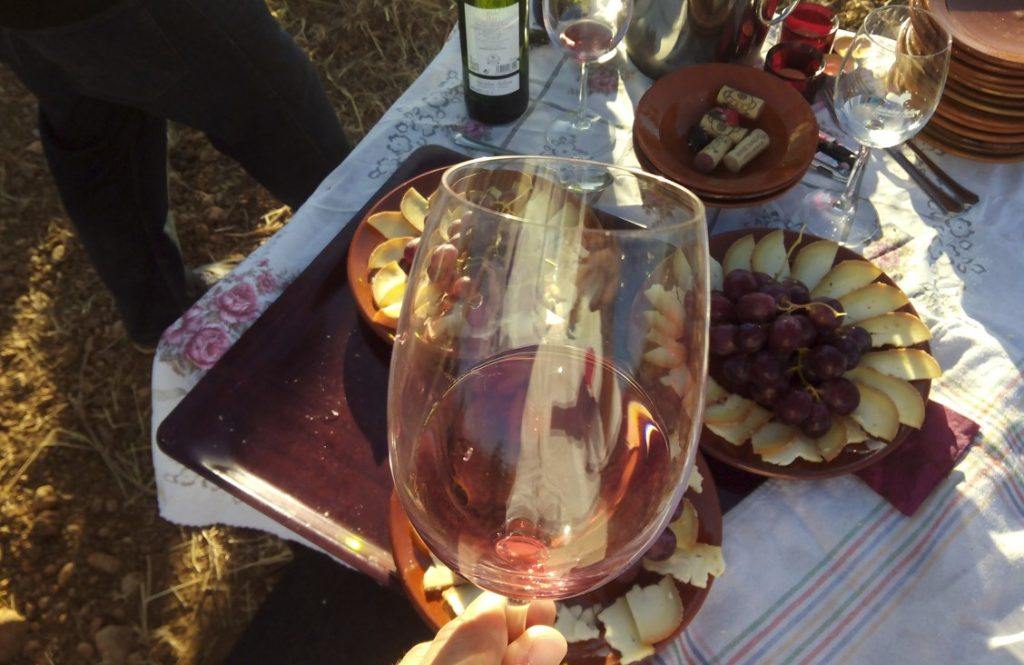
If you want to join a wine tasting experience with like-minded people to learn about different Mallorca wines and have some fun then you should join the wine tasting that takes place weekly in summer. You will taste five wines and these will be combined with tapas. The wines are selected for their contrast to each other and for their singularity. You are not likely to find wines at this wine tasting that you could otherwise find at any restaurant in Mallorca.
Wine Route
Another fun wine experience in Mallorca is to join a wine route where you have someone that will pick you up in a minibus or small vehicle and take you on a route around different wine cellars and their vineyards. There’s always plenty of wine to taste on a day out like this, so it’s a great way to taste and drink wine at the same time as visiting different parts of the island, without actually having to drive yourself.
Normally these wine routes are shared tours in small groups and last all day and include lunch. You will visit three or four bodegas, which are normally unique in their own way and are quite different to one another so that you can experience different sized bodegas and see different wine making processes. You will get to hear from the wine maker on each stop so that you can learn about their passion for their wine and understand why they do certain things in a certain way depending on their unique circumstances. There will be a combination of big, commercial wine cellars that will give you a professional guided tour of their installations and small wine cellars where the wine maker is the owner and they produce wine on a small scale in what looks like a small warehouse or garage.
There’s always plenty of wine to taste on these wine routes, as the people at each wine cellar are keen for the visitors to taste and get to know their wines, in the hope that they will buy a bottle or order it at a restaurant.
Bodega Visits
Another way to experience wine in Mallorca is to go yourself to visit bodegas. You could do your own wine route, using the same idea as above. The problem in this scenario is for the driver, of course. On the other hand, if you do your own wine route and visit different bodegas during one day, you can go at your own pace and spend as much or as little time at each bodega as you wish. The most important bonus of creating your own route is that you choose which wine cellars you visit. And if you are a wine enthustiast with a specific list of bodegas that interest you or if you have a limited amount of time, then it is the ideal option.
There is no reason why you have to visit more than one bodega in Mallorca in one day though. Maybe you prefer a more in-depth visit and don’t wish to rush to get to the next place.
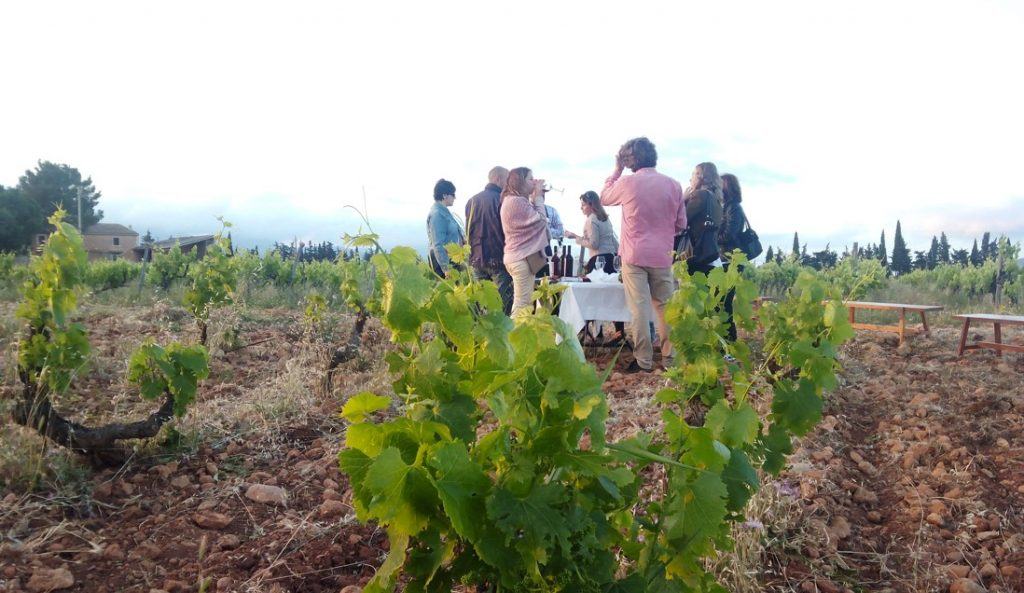
It is always best to book a bodega visit in advance because this way you are sure that they can accommodate you and you are sure that someone will be there to give you information and show you around. All the bodegas mentioned in the section above about which wine cellars to visit offer guided tours of their facilites and wine tastes. Indeed, practically all the bodegas in Mallorca offer this. Some bodegas offer different types of visits depending on what kind of wine experience you want. You can go to the bodega and taste three wines and then move on, or you can book the full vineyard and wine cellar tour with wine tasting and gastronomic tapas. Or you can book something in between the two, depending on what is on offer.
Wine Express Train
Did you know there was a wine express train in Mallorca? Well now you do. The wine express train is a fun way to visit the Mallorcan countryside and see the grapevines and to visit a bodega. Chug through the grapevines enjoying fantastic views on a memorable wine-related experience that is quite unique.
The great thing about the wine express train is that there is a guide onboard who will give you information in different languages about your surroundings. They will tell you about the vineyards you can see from the train, about the varieties of grapes and which bodegas they belong to. They will tell you about where your wine express will stop and about the wine cellar you will visit when it does so.
After the tour on the wine express train, you will get off at the wine cellar and will enjoy a guided visit where you will see the barrels and learn about the wine-making process. Then you will taste five wines served with a selection of local tapas.
We hope that this article has helped you to plan your visit to Mallorca. Have you visited any bodega or winery in Mallorca? Any recommended wine? Do you have any recommendation? Leave us your comment, if you liked the post, share it on your social networks,…
The best activities to enjoy the island: Excursions in Mallorca
Wide choice of hotels with flexible cancellation and the best prices: Hotels in Mallorca
Rent a car in Mallorca at the best prices. Rent a car in Mallorca
Find flights to Mallorca at the best prices: Flights to Mallorca
Boat trips and catamaran tours: Boat trips in Mallorca
More Info about Mallorca: Mallorca Travel Blog
